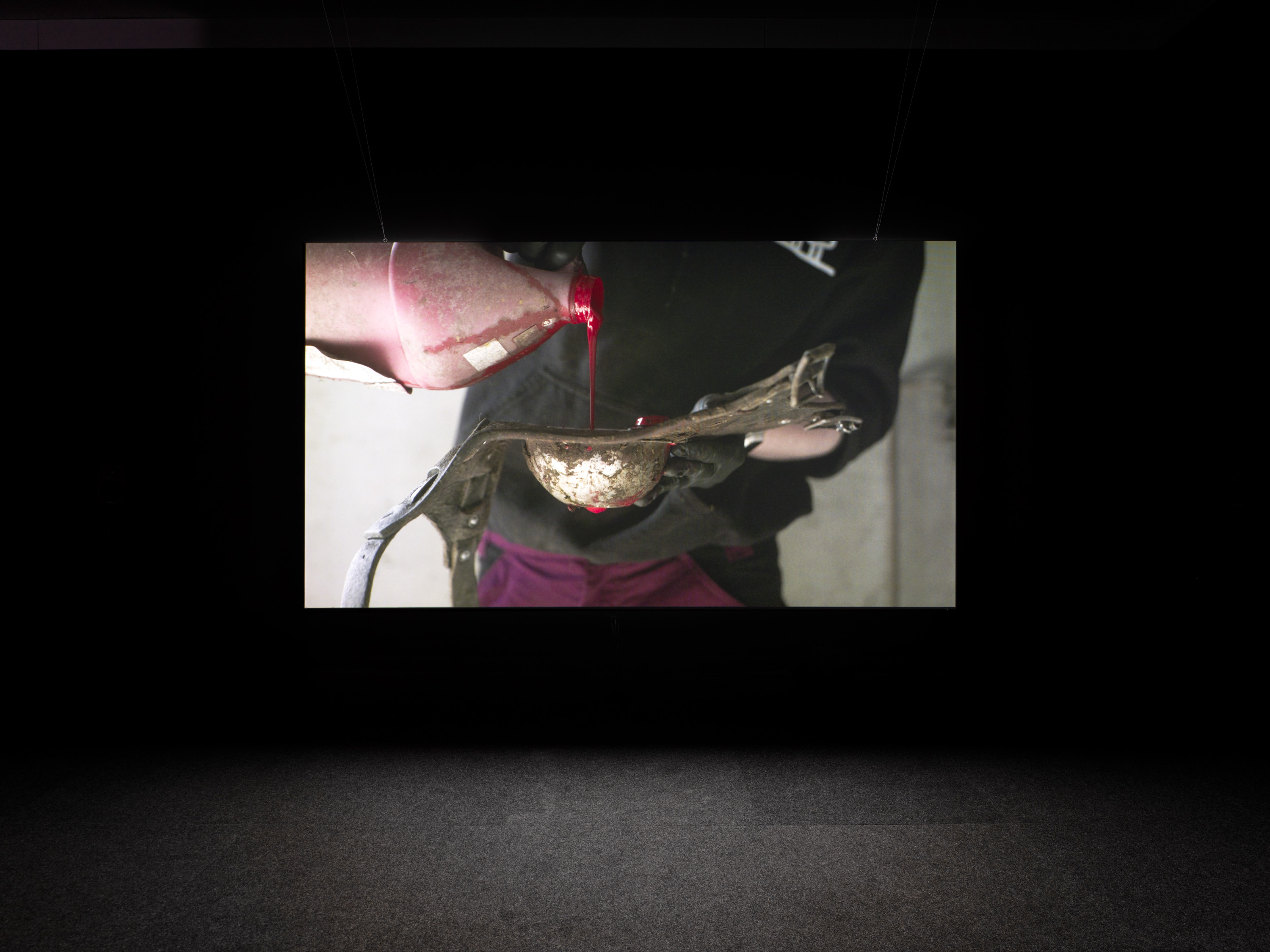Lucy Beech Ooze
Kunstinstituut Melly, Rotterdam
9 June – 19 November 202317-11-2023
There was a period spanning at least three years where it wouldn’t have been a stretch to say that I was obsessed with fatbergs. As evidence: this is not the first text I have written in which I try to anchor their clotted mass of waste matter to an argument hinging on dispersion and obstruction. Lucy Beech’s solo exhibition “Ooze” at Kunstinstituut Melly, as the name suggests, seeps across three films and their corresponding screens over the course of approximately eighty minutes. It’s a slow burn, in which words, paint and genetic matter are disseminated throughout narrative arcs and self-actualizations as experiments and plots unfold. In the film Warm Decembers (2022), the narrator states, “I keep coming back to the same question: What will I keep of what used to be me?” In Reproductive Exile (2018), the protagonist grapples with her fertility journey, in which a science-fictitious clinic repurposes the urine of a menopausal woman to assist in her journey towards conception. In Flush (2023) paint is pushed through the arteries of a human placenta and used to track the sexual proclivities of a freemartin amidst a herd of cows, with both instances chronicling legitimate scientific experiments in hormonal flows. The overall result is an exhibition that reclaims waste — or at least what is considered to be waste — from the clutches of discard, repurposing it through various propositions as something conductive of meaning.

To make the films, Beech worked in tandem with poets, historians, medical practitioners and scientists, while also shadowing waste management specialists under the streets of Berlin. In drawing on the varying speculative potentials of art, writing and science, the films together resist a uniform approach to handling research material — aside from the sheen of 4K blanketing the exhibition. For example, in Warm Decembers, the artifice of framing is put on full show as the camera pans out to reveal the stage-like apparatus containing the action. Comparatively, Flush borrows from documentary and docudrama tropes by including field footage from cow pastures alongside hyper-stylized re-enactments (presumably) of lab experiments. Then, the unsettling effect of a hopeful protagonist amidst a questionable clinical utopia sets the fictional scene for Reproductive Exile (though I’m still not convinced that the rigid acting of the clinic director was intentionally a meta reference to investigations into transhumanism commonplace in genre of science fiction, or if, in fact, it was just a performance left wanting).
The associative stretch of recounting fatbergs the minute I am faced with an exhibition blurb that mentions sewage systems and waste management begins to fall flat here. Yet what remains as a connective tissue — genetic or otherwise — is the fact that the majority of a fatberg is composed of disposable materials resulting from dealing with bodily discharge (flushed wet wipes being the main culprit of blockages). I once read that it takes a team of over twenty people over the course of several weeks to remove a fatberg from a sewer. As a kind of creative coagulation, a fourth screen in the exhibition presents a credit real for each of the three films, running on an infinite loop. I have always thought that artists who espouse collaborative and networked practices of “feminist solidarity” and “holding space together” while still standing autonomous at the center of their work should borrow more readily from the conventions of film — an industry in which a practice of crediting is well established. Usually, in art, citation of labor is left wanting. In this case, Beech undoes the solidity of singular authorship as, at first sightline, viewers are faced with this screen that hangs almost dead center in the room, glaringly white in an otherwise darkened space, and standing out within a constellation of films shot with the crisp but flattened edges of high production. I can’t fault them for this, given my personal desire for proper crediting to happen more readily within the field. At the same time, the centrality of this screen, official in form — black text on white background, uniformly arranged, funder by-lines included — feels a little too self-satisfied. Anywhere else in the space aside from first encounter, and the point would still have been cogent.

The thing about waste is that after its dismissal it still has to go somewhere, be reconfigured again, managed. A fatberg is material proof of this conundrum: below the surface it builds up over time, a pile of daily instances of waste congealing into the eventual rupture of an underground sewage system serving a whole city. What then remains — if I am to finally make this metaphor stick — is an awareness of the social infrastructure inherent to the formation of norms and expectations. In Beech’s exhibition, thanks most notability to Warm Decembers, the ways in which other forms of social infrastructure hold up and support instances of self-transformation and realization come to undo the depressing and life-altering reality of normativity. Cassie Westwood, a poet with whom Beech collaborated and who stands at the center of this film, poised at the microphone, speaks of poets who incorporate drafts and earlier paragraphs tracked in their rewrites. She names these evolving inscriptions “little titans of transition.” Yet, the thing about a “little titan” is that it is an oxymoron. Exceptionally strong, with overwhelming import, a titan resounds, and these supposedly small acts of resistive inscription build up in slow crescendo, actualizing inevitable rupture.
